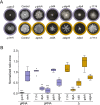CRISPR interference to interrogate genes that control biofilm formation in Pseudomonas fluorescens
- PMID: 31685917
- PMCID: PMC6828691
- DOI: 10.1038/s41598-019-52400-5
CRISPR interference to interrogate genes that control biofilm formation in Pseudomonas fluorescens
Abstract
Bacterial biofilm formation involves signaling and regulatory pathways that control the transition from motile to sessile lifestyle, production of extracellular polymeric matrix, and maturation of the biofilm 3D structure. Biofilms are extensively studied because of their importance in biomedical, ecological and industrial settings. Gene inactivation is a powerful approach for functional studies but it is often labor intensive, limiting systematic gene surveys to the most tractable bacterial hosts. Here, we adapted the CRISPR interference (CRISPRi) system for use in diverse strain isolates of P. fluorescens, SBW25, WH6 and Pf0-1. We found that CRISPRi is applicable to study complex phenotypes such as cell morphology, motility and biofilm formation over extended periods of time. In SBW25, CRISPRi-mediated silencing of genes encoding the GacA/S two-component system and regulatory proteins associated with the cylic di-GMP signaling messenger produced swarming and biofilm phenotypes similar to those obtained after gene inactivation. Combined with detailed confocal microscopy of biofilms, our study also revealed novel phenotypes associated with extracellular matrix biosynthesis as well as the potent inhibition of SBW25 biofilm formation mediated by the PFLU1114 operon. We conclude that CRISPRi is a reliable and scalable approach to investigate gene networks in the diverse P. fluorescens group.
Conflict of interest statement
The authors declare no competing interests.
Figures






References
Publication types
MeSH terms
LinkOut - more resources
Full Text Sources
Other Literature Sources

